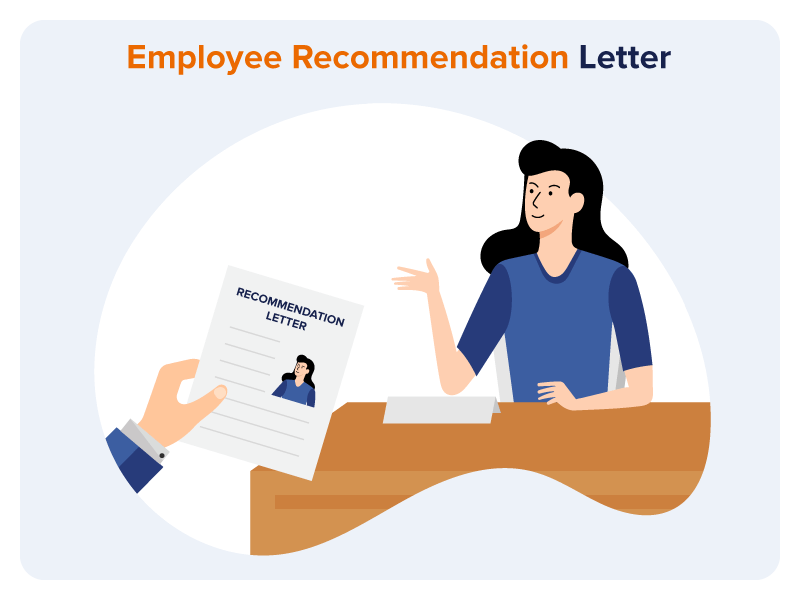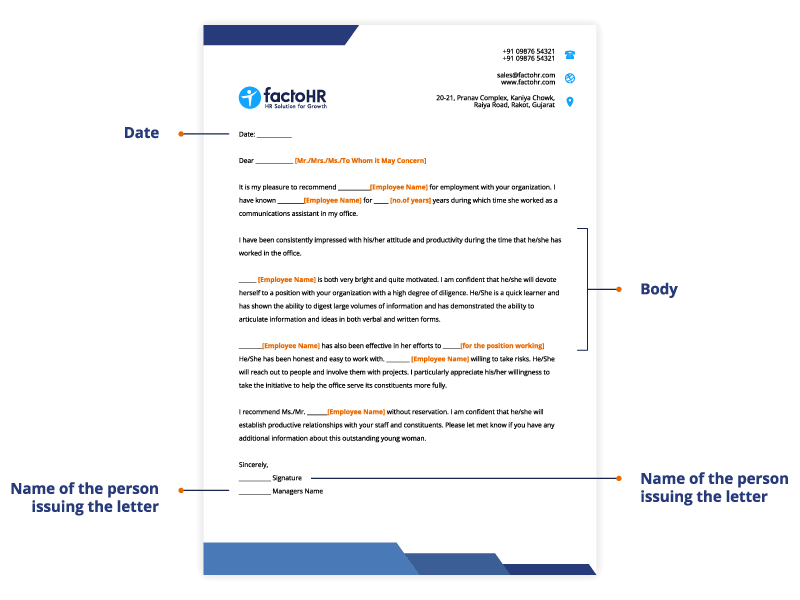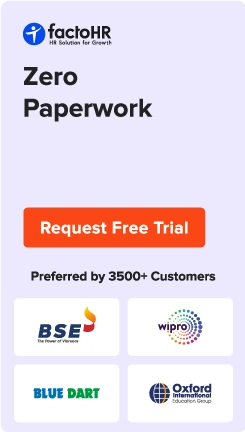Recommendation Letter Format & Templates for Employees

Table of Contents
An employee recommendation letter provides a positive endorsement for the candidate in a competitive job market. Writing such a letter of recommendation can seem like a big responsibility. However, writing one requires researching some of the key features and formatting requirements beforehand.
Sometimes, it can be difficult for HR professionals to strongly recommend a particular employee for the position. Even some organizations do not have a policy of giving recommendations. In this regard, HR professionals can politely turn down the request for a reference.
In this article, we explain what a recommendation letter is, outline the steps for writing one, and provide examples and templates to guide HR professionals in crafting effective recommendation letters.

What is a Recommendation Letter for Employees?
An employee recommendation letter, also known as a letter of reference, is a letter that an employer writes to recommend a former employee, specifying their qualities and skills. The letter positively deems the candidate as ideal for the job. Therefore, employee recommendation letters are typically helpful for employees looking for a new job as they can share them with different hiring managers and get their dream jobs.
Recommendation Letter Format for Employees
This reference letter will help organizations support employees in their job search. It’s a direct statement from another person backing up the applicant’s reliability and competence. Here’s a quick preview of the standard format of Recommendation Letter for Employees.

Download Employee Recommendation Letter Word Format For Free
Sample Letter of Recommendation for Employees
Ms. Manushi Gada
E/2, Shaitan Gali,
Kolkata – 010
+91 63598 87121
September 7, 2025
Xenia Pvt. Ltd.
Pramukh Road
Kolkata
Dear Sir
It’s with great enthusiasm that I recommend Ms. Manushi Gada for the position of [position name] at [company name]. I have worked with [employee name] for over [X] years in the [department name].
During our time together, it became quickly apparent to me that [employee name] was a diligent and quick learner with incredible upward potential. [S/he] continually demonstrated initiative and the ability to innovate. [His/Her] ability to [relevant skills] allowed [him/her] to [specific achievements]. This greatly contributed to our company’s goals.
I can confidently recommend [employee first name] for the [position] at [company name]. I do not doubt that [S/he] will find success at your company.
Sincerely,
[Image of signature]
[Your Name]
[Your Job Title]

Employment Reference Letter Template
Here are some more templates of employee reference letters for different job recommendations. HR professionals can adjust the formatting as per the requirements of the organization.
Sample 1: Employment Reference Letter for Financial Services
Ramesh Iyer
Flat No. 203, Shree Residency
MG Road, Andheri East, Mumbai – 400069, Maharashtra
+91 98765 43210
April 18, 2025
HR Manager
HDFC Bank Ltd.
Senapati Bapat Marg, Lower Parel
Mumbai – 400013, Maharashtra
Dear Sir/Madam,
I am pleased to recommend Ananya Sharma for the position of Financial Analyst at HDFC Bank Ltd. I have worked with Ananya for three years in the Financial Planning and Analysis team at ICICI Securities Ltd.
She has consistently displayed strong analytical abilities, attention to detail, and a deep understanding of financial markets during her tenure in the organisation. She demonstrated expertise in Excel, financial modeling, and risk assessment, and played a key role in streamlining our quarterly reporting process, which reduced turnaround time by 20%.
Ananya’s contribution greatly strengthened our team’s ability to manage high-volume data and deliver accurate financial insights to senior management. She is a dedicated and reliable professional who will undoubtedly bring value to your organization.
I strongly recommend Ananya Sharma for the role of Financial Analyst. Please feel free to contact me at ramesh.iyer@email.com or +91 98765 43210 if you need any additional information.
Sincerely,
(Signature)
Ramesh Iyer
Senior Finance Manager
ICICI Securities Ltd
Sample 2: Employee Recommendation Letter for Teaching Job
[Your Name]
[Your Address]
[City, State, ZIP Code]
[Phone Number]
[Email Address]
[Date]
[Recipient’s Name]
[School Name]
[Address]
[City, State, ZIP Code]
Dear [Recipient’s Name],
I am writing to recommend [Full name of applicant] for the position of [Subject/Teaching Role] at [school Name]. I have worked with [applicant’s first name] for [X years] at [school name].
S/he has proven to be an inspiring educator with excellent classroom management skills. S/he can develop a positive and engaging learning environment and adapt lessons to meet student requirements.
I can confidently recommend [Teacher’s First Name] to make learning fun and engaging for your students to improve their performance.
Please do not hesitate to contact me at [your email] or [your phone number] for any further information.
Sincerely,
[Full Name]
[Job Title/Position]
[School/Institution Name]
Sample 3: Employee Recommendation Letter for Marketing Job
[Your Name]
[Your Address]
[City, State, ZIP Code]
[Phone Number]
[Email Address]
[Date]
[Recipient’s Name]
[Company Name]
[Company Address]
[City, State, ZIP Code]
Dear [Recipient’s Name],
I am delighted to recommend [Candidate full name] for the role of [Job Title] in your marketing team at [Company Name]. I had the opportunity to supervise [Candidate first name] for [X years] at [Your Company Name], where [he/she] made a significant impact.
[Candidate first name] is a creative and strategic thinker, best known for developing highly converting campaigns for our clients. [She/he] has hands-on experience in digital marketing, SEO, branding, social media, and analytics. You can count on [candidate first name] to increase engagement, drive revenue growth, and expand brand reach.
I wholeheartedly recommend [Employee’s First Name] for the position.
Sincerely,
[Full Name]
[Job Title]
[Company Name]
Sample 4: Recommendation Letter for Managerial Position
[Your Name]
[Your Address]
[City, State, ZIP Code]
[Phone Number]
[Email Address]
[Date]
[Recipient’s Name]
[Company Name]
[Company Address]
[City, State, ZIP Code]
Dear [Recipient’s Name],
I am pleased to recommend [candidate Full Name] for the position of [Managerial Role] at [Company Name]. During my [X] years of working with [candidate first name], I have known [him/her] to be capable of handling the duties of a manager.
As a manager, [candidate first name] can motivate teams, delegate work effectively, and drive projects to completion. [He/She] successfully oversaw [number of team members or specific projects] to meet goals on time and within budget.
I do not doubt that [candidate first name] will find success in your organization.
Sincerely,
Name
Job Title
Company Name

Tips for Writing a Strong Letter of Recommendation
While drafting an employee recommendation letter, consider the following tips to make it stand out to admissions officers, potential employers, or anyone else reviewing the letter.
Include necessary details: Ask the candidate to provide a copy of their job description, resume, and achievements specific to the role they are applying for.
Be specific: Personalize the letter to illustrate why this person is the best candidate. Writing from the perspective of the hiring manager will help HR professionals draft it more effectively.
Show enthusiasm: Avoid any comments that could be construed in a negative light. Instead, a strong comparison of the candidate’s strengths will help them stand out as a better choice.
Keep it formal and concise: Write the employee recommendation letter in a business letter format in Arial or Times New Roman using a 12-point font size. It is likely that the recipient reads hundreds of letters in a week. Keep the employee referral letter concise and to the point.
How to Write a Letter of Recommendation for Employees?
An employee recommendation letter should be written in a professional tone and with a touch of personalisation. Here are some steps to follow to create an effective recommendation letter for employees:
Step 1. Follow Formal Letter Writing Rules
As a professional letter to an employer, it should follow a standard letter-writing format. The recommender’s information should appear in the top left-hand corner, including job title, company, and official email address. At the start of the employee recommendation letter, mention the candidate’s name, preceded by a salutation, or simply write “To Whom It May Concern.”
Step 2. Start with a Brief Opening
Start the letter with a positive enthusiasm for the opportunity to recommend the candidate.
For example: “It is my pleasure to recommend Satish for the opportunity to work with your organization.” This prompts the hiring manager to learn more about why the organization is so eager to recommend them.
Step 3. Outline the Letter’s Intent
In the opening paragraph of the letter, explain the history of working with the candidate. Also mention how long the candidate has been known. This adds credibility to the assessment.
For example: “I have worked with Ananya for three years in the financial planning and analysis team at ICICI Securities Ltd.”
Step 4. Explain why the Candidate is a Good Fit for the Job
Explain why the candidate is a good fit for the open role by referring to their achievements in their past role. Give an unbiased description of the candidate’s duties and responsibilities related to the past position.
Step 5. Provide Specific Examples and Anecdotes
Make the recommendation letter more credible by including some skills and accomplishments of the candidate. Also, explain how the candidate will use them to be successful in the role for which they are applying.
Step 6. Write a Closing Statement
In the closing paragraph, mention any additional information about the candidate if necessary. End with a summary (1-2 lines) explaining why the candidate would be a good fit for the opportunity. The recommender can also mention their contact details (phone number and email address) so that the recipient can verify the authenticity of this recommendation letter.
Step 7. Include a Closing Phrase and Signature
Conclude the letter with the recommender’s name, title, and signature as shown below:
“Sincerely,
(Signature)
Ramesh Iyer
Senior Finance Manager
ICICI Securities Ltd.”

Closing Notes
An employee recommendation letter acts as a positive endorsement of an employee’s skills and abilities. All it takes is to follow a structured format to show the candidate’s achievements from a personal angle. Lastly, keep the letter concise, and proofread before sending the reference letter for an employee. Also, be thorough with all the required details.
Did you know that over 85% of organizations are automating HR management processes to reduce time and increase productivity? Automate HR with factoHR!
Book a demo and see factoHR in action today!
What to do when You are Preparing a Reference Letter for an Employee?
When preparing a reference letter for an employee, gather relevant information about the employee, establish your relationship with them, use a formal format, and provide a brief introduction. Focus on highlighting the employee’s strengths, skills, and accomplishments with specific examples, and address the requirements of the job they are applying for.
Are there any Specific Instructions that Need to be Added in Reference Letters?
Many times, an employee recommendation letter has many requirements to fulfill before submitting it. It could mean that the letter is part of the application process and is essential to provide. There might be requirements to create a digital letter instead of a physical one. Another requirement might be to include the name of the manager and their contact details. The best way to properly write reference letters is to know all the requirements of the former employee.
Can a Recommendation Letter be Handwritten?
Yes, an employee recommendation letter can be handwritten. In some cases, a handwritten letter adds a personal touch and authenticity to the recommendation. However, it’s essential to ensure that the handwriting is neat and legible, as a messy letter may not leave a positive impression on the recipient. Alternatively, typed recommendation letters are also widely accepted and often preferred in professional settings due to their readability and formality. The choice between a handwritten and typed letter depends on the context and the preferences of the person writing the letter and the recipient.
Is It Necessary to Mention Weaknesses in the Employee Recommendation Letter?
No, it is not necessary to mention weaknesses in an employee recommendation letter. The primary purpose of a recommendation letter is to highlight the candidate’s strengths, skills, and positive qualities that make them a suitable fit for the desired position. The goal is to present the candidate in the best possible light and showcase their capabilities to potential employers or academic institutions.
How Long Should an Employee Recommendation Letter be?
An employee recommendation letter typically ranges from one to two pages in length. It should be long enough to provide sufficient detail and specific examples that highlight the candidate’s qualifications, skills, and achievements. However, it’s essential to keep the letter concise and focused on the most relevant information. Avoid unnecessary repetition and tangents, and instead, concentrate on showcasing the employee’s strengths and suitability for the desired position.

Modernize your HR tasks with factoHR today
Experience the digitalization of everyday business activities with factoHR's modern and compatible solutions for every need.

© 2025 Copyright factoHR


